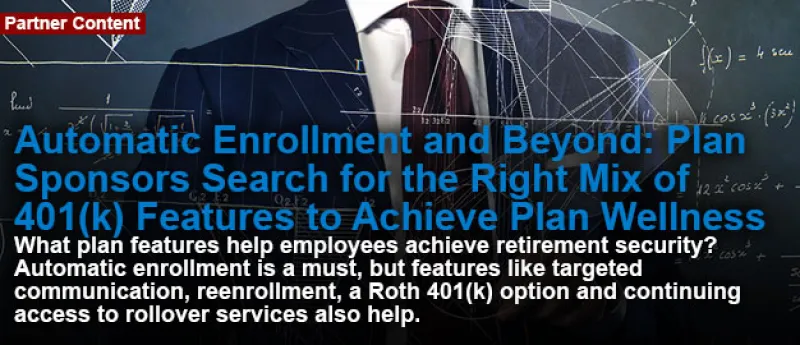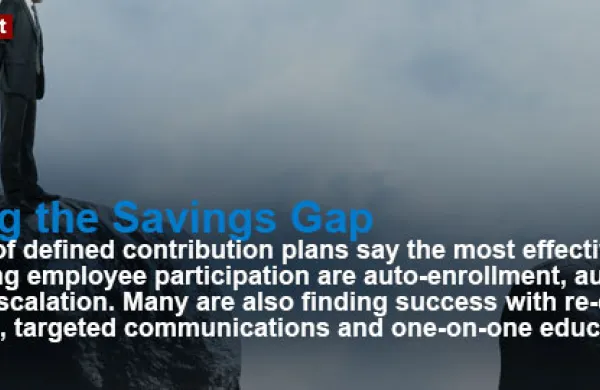The underlying objective of a 401(k) plan is to help employees achieve a secure retirement. The degree to which the plan helps them to reach that goal defines plan wellness. What features enable sponsors to attain plan wellness? Which plans are most effective at mitigating risks to employees' financial health and retirement security? Institutional Investor's recent survey of plan sponsors, consultants and advisers, in partnership with Prudential, identifies features that drive positive employee behavior. Most plan sponsors consider the following to be effective:
- One-on-one advice on asset allocation and financial planning (62 percent)
- Focus on keeping plan fees and other costs low (61 percent)
- Automatic enrollment (55 percent)
- Target date funds (55 percent)
- Online retirement planning tools (53 percent)
Automatic features may help to improve participants' asset allocation over time, says Ryan Gardner, managing partner and senior consultant at Fiduciary Investment Advisors, by lessening the probability that they will overreact to volatile markets. They also eliminate the need for plan sponsors to convince employees to be more diversified, says Thomas Foley, director of employee benefits at building materials manufacturer USG Corp., enabling the plan sponsor to focus on the fundamental issue of getting participants to save more. But plan sponsors today are still adding to their 401(k) toolboxes; with some of these newer elements, they are looking beyond automatic features for new ways to persuade specific audiences to start saving or boost their savings.
Reenrollment: To get employees to revisit their choices or consider new ones, some plan sponsors require them to reselect their 401(k) investments, either periodically or when a major event takes place, such as a merger or acquisition or a move to a different provider. “Very few plan sponsors are comfortable just reenrolling everyone,” says Lori Lucas, defined contribution practice leader at Callan Associates, “but if there's a catalyst for it, they're more comfortable.” USG, which instituted auto-enrollment in 1997, has had an above-average participation rate since then, now at about 80 percent. But it was concerned that participants were not diversifying their assets sufficiently. When USG switched recordkeepers in 2014, it boosted its employer match and made the default option for auto-enrollment a TDF. More participants accepting the TDF has resulted in greater diversification, says Foley. Several other plan sponsors told us they are now considering reenrollment, either as a recurring practice or as a one-time exercise.
Targeted communication: Some plan sponsors are adopting targeted communication as a way to reach their outliers: employees who opt out instead of allowing themselves to be auto-enrolled or who do not respond to inducements to increase their contributions. Some targeted efforts are geographic: BMC Software, for example, holds special “Retirement Week” events and brings advisers from its recordkeeper on-site periodically for one-on-one meetings. “There's a waiting list for the sessions,” says Natasha Taylor, director of global benefits. Distiller Brown-Forman sponsors employee resource groups (ERGs) to give voice to segments including young professionals, women and baby boomers. Two years ago it began asking ERGs to engage in 401(k) and other benefit-related communications. Since then, support from ERGs for greater plan participation “has just blossomed,” says Wimbec. “They'll reach out to us to incorporate information about the plan in their meetings.”
Optimizers: Employees are more likely to save, and save more, if they have a target — specifically, a date by which they project that their income, savings and other assets will meet their needs in retirement. Most large recordkeepers now offer an optimizer, as do a number of third-party providers. Ford Motor Co., whose employees are transitioning from a retirement benefits program centered on a defined benefit plan to a defined contribution-focused structure, uses Towers Watson's FiT Age analyzer to gauge employees' savings behavior and retirement readiness. “You take away the defined benefit plan and the investment impact on retirement readiness changes. We have to make sure employees are investing the right way,” says Mark Kopp, associate director of U.S. defined contribution plans at Ford.
The Roth option: Catering to participants who anticipate higher taxes after they have retired or who have a long time horizon for compounded earnings to accumulate, some plan sponsors now allow them to allocate some or all of their contributions to a Roth 401(k) account. As with a Roth IRA, contributions are made post-tax, accumulate tax-free thereafter and are not taxed upon distribution. Brown-Forman added a Roth option in 2014; although Roths are generally thought to appeal more to younger employees, Wimbec says she had received inquiries from a range of age groups. “Making sure they have tax-efficient deferral options is an important next step in improving 401(k)s,” says Robyn Credico, defined contribution consulting leader at Willis Towers Watson.
Continuing services: “Think about your former employees; some may become employees again,” says a pension executive at a large financial firm. Some employers allow ex-employees to continue on the plan's previous loan repayment schedule after they leave; some, too, permit them to continue accessing their rollover service, through which they can fold defined contribution accounts from previous employers into their current 401(k). The goal is to minimize redemptions from the plan even after the employee takes another job or retires. This feature could gain importance as more people continue working and delay accessing their 401(k) accounts until they are well past the traditional retirement age.
These newer features reflect an evolving set of plan sponsors' concerns: not only to boost savings but also to communicate more effectively with employees — especially those who are hardest to reach, to encourage them to focus more on post-retirement planning — and to make sure the plan addresses important employee concerns such as tax liability. As employers look for ways to supplement their plan's automatic features, and as plan participants approach retirement in larger numbers, plan sponsors can be expected to devote more attention to these concerns and to exploring innovations that address them.
ABOUT THE SURVEY
This study was developed by Institutional Investor, in partnership with Prudential, to identify the investment risks and behavioral challenges that need to be addressed throughout the retirement planning process and how plan sponsors, advisers and consultants are trying to overcome them.
To support this research, a survey was distributed to Institutional Investor's audience of plan sponsors as well as advisors and consultants between January and February 2016. We received 511 completed survey responses from the plan sponsor audience and 295 completed survey responses from advisers and consultants.
Auto Enrollment: An automatic contribution arrangement that can be used as a feature in a retirement plan to allow employers to enroll employees in the company’s plan automatically upon meeting eligibility requirements.
Auto Escalation: A plan design option that allows a plan sponsor to increase participant deferrals annually by a set increment.
RISKS: Investing involves risk. Some investments are riskier than others. The investment return and principal value will fluctuate, and shares, when sold, may be worth more or less than the original cost, and it is possible to lose money. Past performance does not guarantee future results. Asset allocation and diversification do not assure a profit or protect against loss in declining markets.
The target date is the approximate date when investors plan to retire and may begin withdrawing their money. The asset allocation of the target date funds will become more conservative as the target date approaches by lessening the equity exposure and increasing the exposure in fixed income-type investments. The principal value of an investment in a target date fund is not guaranteed at any time, including the target date. There is no guarantee that the fund will provide adequate retirement income. A target date fund should not be selected based solely on age or retirement date. Participants should carefully consider the investment objectives, risks, charges and expenses of any fund before investing. Funds are not guaranteed investments and the stated asset allocation may be subject to change. It is possible to lose money by investing in securities, including losses near and following retirement.
© 2016 Prudential Financial, Inc. and its related entities. Prudential, the Prudential logo, the Rock symbol and Bring Your Challenges are service marks of Prudential Financial, Inc., and its related entities, registered in many jurisdictions worldwide.
0295121-00001-00






